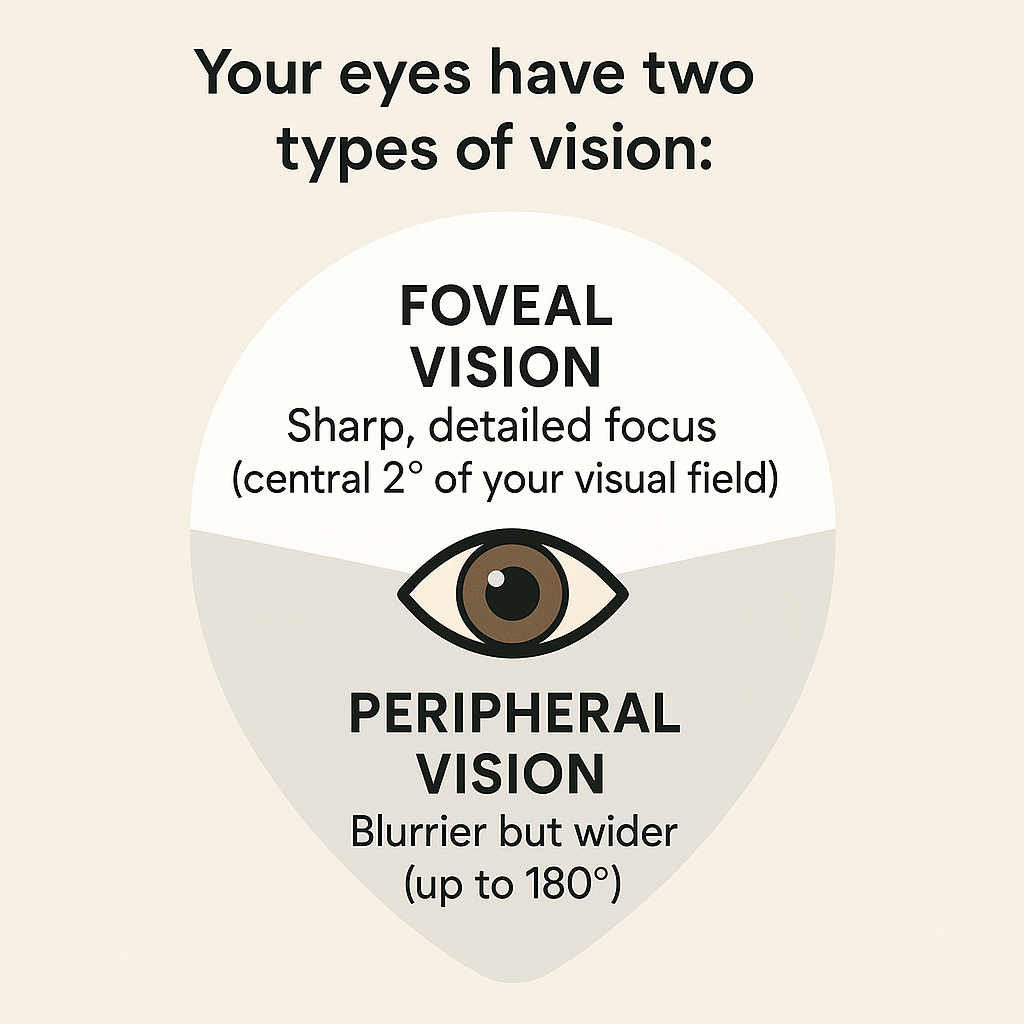Why Your Side Vision Is the Key to Speed Reading
Most people read like they’re looking through a telescope: focusing narrowly on one word at a time.
But what if you could widen your “reading lens” to capture entire phrases in a single glance?
That’s the power of peripheral vision—the often-overlooked skill that separates average readers from speed reading pros.
This guide teaches you how to train your peripheral vision to expand your reading span, reduce eye strain, and absorb information faster.
In just 7 days, you’ll unlock the ability to read 3–5 words per fixation, not just 1–2. Let’s dive in!
Also read: The Chunking Method: How to Read Groups of Words

The Science of Peripheral Vision in Reading
Your eyes have two types of vision:
- Foveal Vision: Sharp, detailed focus (central 2° of your visual field).
- Peripheral Vision: Blurrier but wider (up to 180°).
Why It Matters:
- Speed: Peripheral vision lets you preview upcoming words, priming your brain for faster processing.
- Comprehension: Seeing word groups improves context retention (University of Southampton, 2022).
- Eye Health: Reduces fatigue by minimizing rapid eye movements (saccades).
Day-by-Day Training Plan
Day 1: Baseline Test
- Step 1: Use a tool like ReadingSoft to measure your current words per fixation (WPF).
- Step 2: Read a paragraph normally, noting how many words you see per glance.
Day 2–3: Pointer Practice
- Exercise: Use a pen to guide your eyes. Focus on the pen’s tip while consciously noticing words 1–2 inches to the left and right.
- Goal: Expand from 2 to 3 words per fixation.
Day 4–5: The “Soft Gaze” Technique
- How to Do It:
- Relax your eyes and soften your focus.
- Read a line while letting your periphery capture edge words.
- Gradually widen your gaze to include 4–5 words.
- Tool: Use a newspaper column or app like BeeLine Reader to practice.
Day 6: Peripheral Vision Games
- Flashcard Drill: Write word groups on cards (e.g., “speed reading techniques”) and flash them briefly while focusing on the center.
- Digital Tool: Try EyeQ’s peripheral vision exercises to gamify training.
Day 7: Integration Challenge
- Task: Read a full page using your expanded peripheral vision. Aim for 30% fewer eye movements than Day 1.

Tools to Accelerate Progress
- RSVP Apps (Spreeder, ReadMe!): Flash words in your central vision while training periphery to anticipate upcoming text.
- Wide-Format Texts: Use browser extensions like Reedy to convert articles into multi-column layouts.
- Peripheral Vision Glasses (DIY): Cut vertical slits in cardboard glasses to simulate tunnel vision, then gradually widen them.
Also Read: Top Speed Reading Apps
Common Challenges & Fixes
Blurred Edges: Struggling to recognize peripheral words.
- Fix: Start with larger fonts and high-contrast text.
Mental Overload: Feeling overwhelmed by more words.
- Fix: Practice on familiar, simple texts (e.g., children’s books).
Regression: Backtracking due to missed words.
- Fix: Cover finished lines with a blank card to enforce forward momentum.
Real-Life Success Stories
- Emma, Copywriter: Doubled her editing speed by spotting errors in her periphery.
- Carlos, PhD Student: Cut literature review time by 40% after mastering peripheral previewing.
Peripheral Vision vs. Skimming
- Peripheral Vision: Engages with all text in a widened span.
- Skimming: Selectively ignores details. Use both: peripheral vision for dense material, skimming for quick reviews.
FAQs
Q: Can older adults improve peripheral vision?
A: Yes! Neuroplasticity allows vision training at any age (Journal of Vision, 2023).
Q: Does screen size matter?
A: Larger screens (or holding devices farther away) help widen your visual span.
Q: How long should I practice daily?
A: 10–15 minutes is ideal to avoid eye strain.
Conclusion: See More, Read Faster
Expanding your peripheral vision isn’t just a speed reading hack—it’s a fundamental upgrade to how you interact with text. By dedicating just one week to these exercises, you’ll unlock a broader, more efficient reading style that saves time and sharpens comprehension.
Your Next Steps:
- Take the Baseline Test: Measure your starting point today.
- Download BeeLine Reader: Start practicing with color-guided text.
Remember: Your eyes are muscles. Train them wisely, and they’ll reward you with lifelong reading superpowers.

